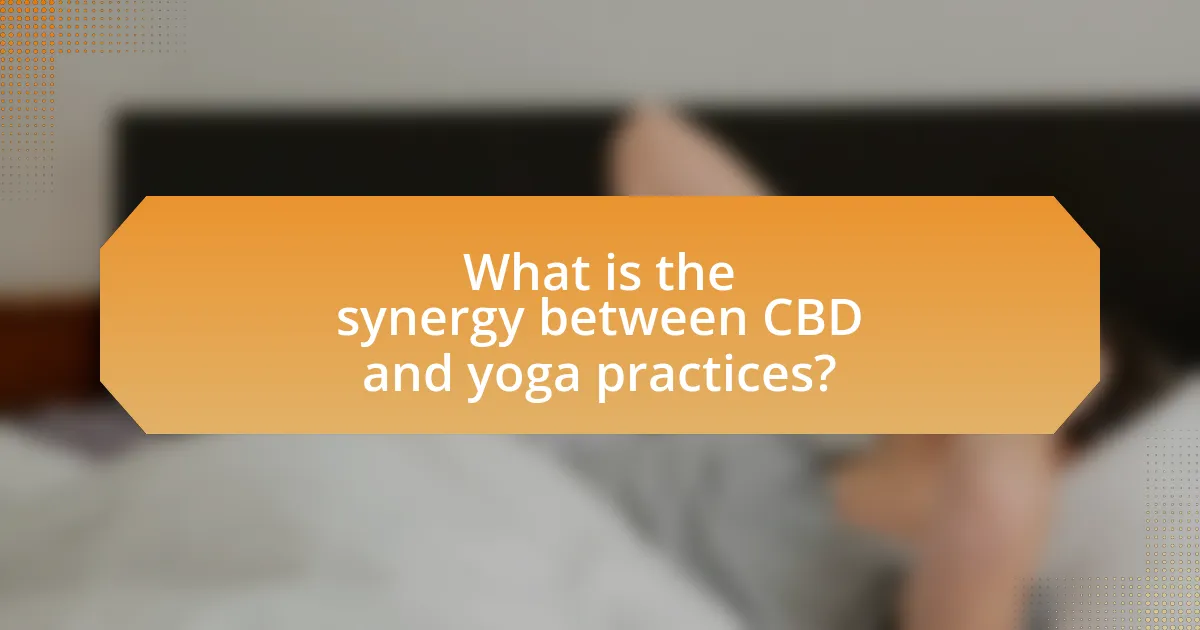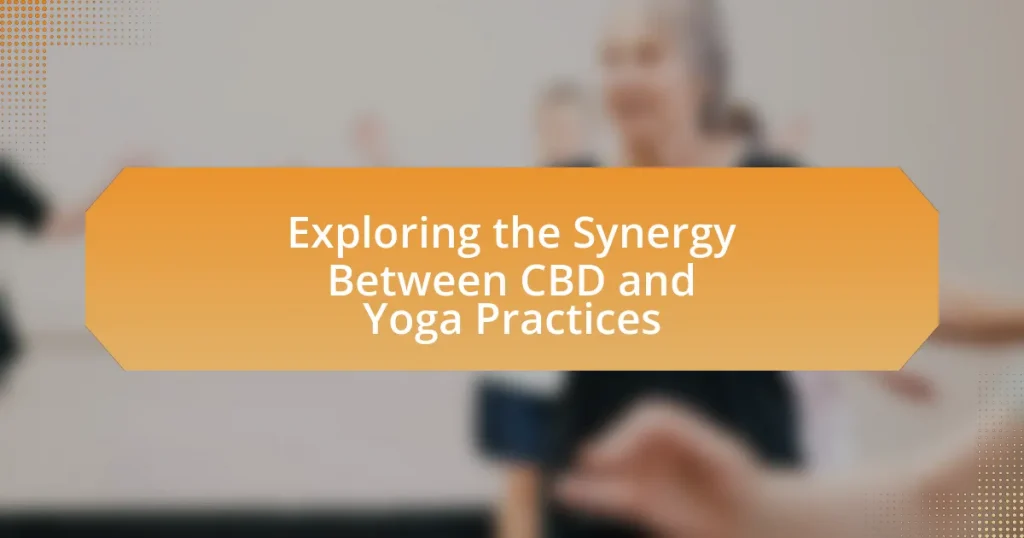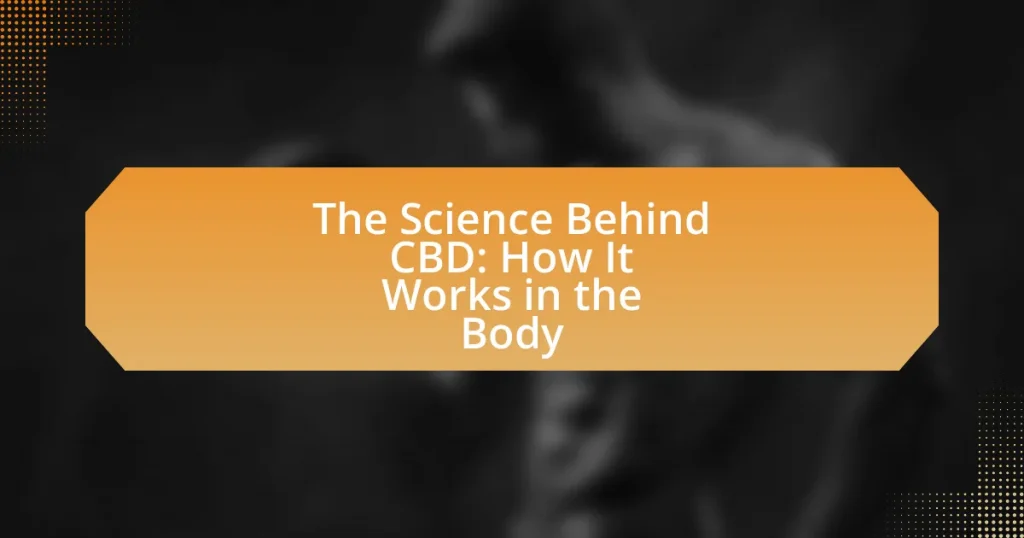The article explores the synergy between CBD (cannabidiol) and yoga practices, highlighting how their combined effects can enhance relaxation, reduce stress, and improve overall well-being. It discusses the physiological benefits of CBD, including its anti-anxiety and anti-inflammatory properties, which can facilitate a more effective yoga experience. Additionally, the article examines the historical connections between CBD and yoga, the evolution of CBD use in yoga communities, and practical tips for safely incorporating CBD into yoga routines. It also addresses common misconceptions about CBD and its role in enhancing yoga practices, supported by scientific evidence.

What is the synergy between CBD and yoga practices?
The synergy between CBD and yoga practices lies in their complementary effects on relaxation and stress reduction. CBD, or cannabidiol, is known for its potential to alleviate anxiety and promote a sense of calm, which can enhance the meditative and restorative aspects of yoga. Research indicates that CBD interacts with the endocannabinoid system, potentially reducing inflammation and pain, thereby improving physical comfort during yoga sessions. A study published in the Journal of Pain Research found that CBD can significantly reduce chronic pain, which may facilitate a more enjoyable and effective yoga practice. This combination allows practitioners to achieve deeper states of relaxation and mindfulness, ultimately enhancing the overall experience and benefits of yoga.
How do CBD and yoga complement each other?
CBD and yoga complement each other by enhancing relaxation and reducing stress, which can improve the overall yoga experience. CBD, known for its anti-anxiety and anti-inflammatory properties, can help practitioners achieve a deeper state of mindfulness and physical comfort during yoga sessions. Research indicates that CBD interacts with the endocannabinoid system, potentially promoting a sense of calm and focus, which aligns with the meditative aspects of yoga. This synergy allows individuals to engage more fully in their practice, leading to improved mental clarity and physical flexibility.
What are the physiological effects of CBD that enhance yoga practice?
CBD has several physiological effects that enhance yoga practice, including reduced anxiety, improved focus, and decreased inflammation. These effects contribute to a more relaxed state of mind, allowing practitioners to engage more fully in their yoga sessions. Research indicates that CBD interacts with the endocannabinoid system, which plays a role in regulating mood and stress responses, thereby promoting a sense of calm and enhancing mental clarity during practice. Additionally, studies have shown that CBD can alleviate muscle soreness and joint pain, facilitating better physical performance and recovery, which is crucial for yoga practitioners aiming to improve flexibility and strength.
How does yoga influence the effectiveness of CBD?
Yoga enhances the effectiveness of CBD by promoting relaxation and reducing stress, which can amplify the therapeutic effects of CBD. Research indicates that both yoga and CBD can lower anxiety levels and improve overall well-being, creating a synergistic effect. A study published in the Journal of Clinical Psychology found that mindfulness practices, such as yoga, significantly reduce anxiety, which may enhance the calming effects of CBD when used together. This combination can lead to improved mental clarity and emotional balance, making the overall experience more beneficial.
What are the historical connections between CBD and yoga?
The historical connections between CBD and yoga primarily stem from the traditional use of cannabis in ancient Indian culture, where both practices originated. In ancient texts, cannabis was often associated with spiritual practices and was used to enhance meditation and mindfulness, which are core components of yoga. Historical evidence suggests that yogis utilized cannabis to achieve deeper states of consciousness and relaxation, aligning with the therapeutic properties attributed to CBD today. Furthermore, the integration of CBD into modern yoga practices reflects a continuation of this ancient relationship, as practitioners seek to enhance their physical and mental well-being through both yoga and the calming effects of CBD.
How has the use of CBD evolved in yoga communities?
The use of CBD in yoga communities has evolved significantly, transitioning from a niche interest to a widely accepted practice. Initially, yoga practitioners explored CBD for its potential benefits in enhancing relaxation and reducing anxiety during sessions. As research highlighted CBD’s anti-inflammatory properties and its ability to alleviate pain, more yoga studios began incorporating CBD-infused products, such as oils and edibles, into their offerings. This shift has been supported by a growing body of anecdotal evidence and studies indicating that CBD can enhance mindfulness and improve overall well-being, making it a complementary addition to yoga practices.
What cultural significance does CBD hold in relation to yoga?
CBD holds cultural significance in relation to yoga as it is often used to enhance relaxation, mindfulness, and overall well-being during yoga practices. The integration of CBD into yoga culture reflects a growing trend towards holistic health, where practitioners seek natural remedies to support their physical and mental states. Research indicates that CBD may help reduce anxiety and improve focus, which aligns with the meditative aspects of yoga. This synergy is evident in the increasing number of yoga studios offering CBD-infused classes and products, highlighting a cultural shift towards combining traditional practices with modern wellness solutions.
What are the potential benefits of combining CBD with yoga?
Combining CBD with yoga can enhance relaxation, reduce anxiety, and improve overall mindfulness during practice. Research indicates that CBD may help alleviate stress and promote a sense of calm, which can complement the meditative aspects of yoga. A study published in the Journal of Psychopharmacology found that CBD significantly reduced anxiety in participants, suggesting its potential to enhance the mental clarity and focus that yoga aims to achieve. Additionally, CBD’s anti-inflammatory properties may aid in muscle recovery and pain relief, allowing practitioners to engage more fully in their yoga sessions.
How can CBD improve mental focus during yoga sessions?
CBD can improve mental focus during yoga sessions by enhancing relaxation and reducing anxiety, which allows practitioners to concentrate better on their movements and breath. Research indicates that CBD interacts with the endocannabinoid system, promoting a state of calmness and mental clarity. A study published in the Journal of Psychopharmacology found that CBD significantly reduced anxiety levels in participants, suggesting its potential to help individuals maintain focus during mindfulness practices like yoga. By alleviating distractions caused by stress and anxiety, CBD enables a deeper connection to the body and mind, facilitating a more immersive yoga experience.
What role does CBD play in pain relief for yoga practitioners?
CBD plays a significant role in pain relief for yoga practitioners by interacting with the body’s endocannabinoid system, which helps regulate pain and inflammation. Research indicates that CBD can reduce chronic pain and inflammation, making it beneficial for individuals engaging in physical activities like yoga. A study published in the Journal of Pain Research found that CBD effectively alleviated pain in patients with conditions such as arthritis and multiple sclerosis, supporting its use among yoga practitioners who may experience similar discomforts.
How can practitioners safely incorporate CBD into their yoga routines?
Practitioners can safely incorporate CBD into their yoga routines by starting with a low dosage and gradually increasing it while monitoring their body’s response. This approach allows individuals to assess how CBD affects their flexibility, relaxation, and overall experience during yoga sessions. Research indicates that CBD may help reduce anxiety and enhance relaxation, which can complement the meditative aspects of yoga. A study published in the Journal of Pain Research found that CBD can alleviate discomfort, potentially improving the practice for those with chronic pain. Therefore, beginning with a low dose, such as 5-10 mg of CBD oil or edibles, and adjusting based on personal experience can facilitate a safe integration of CBD into yoga routines.
What dosage of CBD is recommended for yoga practitioners?
The recommended dosage of CBD for yoga practitioners typically ranges from 10 to 30 milligrams per day. This dosage is suggested based on individual factors such as body weight, metabolism, and the specific effects desired, such as relaxation or pain relief. Research indicates that starting with a lower dose and gradually increasing it allows practitioners to find the optimal amount that works for them, ensuring both safety and effectiveness in enhancing their yoga experience.
What are the best forms of CBD to use before or after yoga?
The best forms of CBD to use before or after yoga are CBD oils and tinctures, as they provide quick absorption and targeted effects. CBD oils can be taken sublingually, allowing for rapid onset of relaxation and pain relief, which can enhance the yoga experience. Tinctures, similarly, offer a convenient method for dosing and can help reduce anxiety and improve focus during practice. Studies have shown that CBD can alleviate muscle soreness and inflammation, making it beneficial for recovery post-yoga.
What are the common misconceptions about CBD and yoga?
Common misconceptions about CBD and yoga include the belief that CBD is a psychoactive substance and that it can replace traditional yoga practices. CBD, or cannabidiol, is non-psychoactive, meaning it does not produce a “high” like THC does, which is often misunderstood. Additionally, some people think that using CBD can enhance yoga performance or replace the mental and physical benefits gained from regular practice, but research indicates that while CBD may aid in relaxation and recovery, it does not substitute for the holistic benefits of yoga itself.
How do myths about CBD affect its acceptance in yoga practices?
Myths about CBD significantly hinder its acceptance in yoga practices by perpetuating misconceptions regarding its effects and legality. For instance, the belief that CBD causes psychoactive effects similar to THC can deter practitioners who seek a clear mind during yoga sessions. Additionally, myths surrounding the legality of CBD, despite its federal legalization in the U.S. under the 2018 Farm Bill, create unnecessary fear among yoga instructors and participants. Research indicates that misinformation can lead to a lack of trust in CBD products, which ultimately affects their integration into wellness routines, including yoga. This skepticism can prevent individuals from experiencing the potential benefits of CBD, such as enhanced relaxation and reduced anxiety, which align well with the goals of yoga practice.
What evidence exists to debunk these misconceptions?
Evidence to debunk misconceptions about the synergy between CBD and yoga practices includes scientific studies demonstrating the therapeutic effects of CBD on anxiety and stress, which can enhance the benefits of yoga. For instance, a study published in the Journal of Clinical Psychology in 2019 found that CBD significantly reduced anxiety levels in participants, suggesting that its incorporation into yoga practices may improve mental clarity and relaxation. Additionally, research from the National Institutes of Health indicates that CBD can alleviate inflammation and pain, which supports physical comfort during yoga sessions. These findings collectively challenge the misconception that CBD does not have a beneficial role in enhancing yoga practices.
What are the best practices for integrating CBD into yoga?
The best practices for integrating CBD into yoga include starting with a low dosage, selecting high-quality CBD products, and timing the consumption appropriately. Starting with a low dosage allows individuals to assess their tolerance and effects, which is crucial for a positive experience. High-quality CBD products, preferably those that are third-party tested, ensure safety and efficacy, as contaminants can affect both health and yoga performance. Timing is also essential; consuming CBD about 30 to 60 minutes before a yoga session can enhance relaxation and focus, improving the overall practice. Research indicates that CBD may help reduce anxiety and promote relaxation, which can enhance the benefits of yoga (Blessing et al., 2015, “Cannabidiol as a Potential Treatment for Anxiety Disorders”).
How can individuals tailor their CBD use to enhance their yoga experience?
Individuals can tailor their CBD use to enhance their yoga experience by selecting the appropriate dosage and timing of consumption. Research indicates that a dosage of 10-30 mg of CBD can help reduce anxiety and improve focus, which are beneficial for yoga practice. Consuming CBD 30-60 minutes before a yoga session allows for optimal effects, promoting relaxation and enhancing mindfulness during practice. Additionally, using CBD topicals can provide localized relief for sore muscles, further improving the overall yoga experience.
What tips can help beginners navigate CBD and yoga effectively?
To navigate CBD and yoga effectively, beginners should start by understanding the appropriate dosage of CBD for their individual needs, as this can enhance relaxation and focus during yoga practice. Research indicates that CBD can reduce anxiety and improve overall well-being, which may enhance the yoga experience. Beginners should also choose high-quality, lab-tested CBD products to ensure safety and efficacy, as the market can be saturated with unreliable options. Additionally, integrating CBD into a pre-yoga routine, such as taking it 30 minutes before practice, can help maximize its benefits. Finally, beginners should listen to their bodies and adjust their CBD use based on personal responses, as individual reactions can vary significantly.



